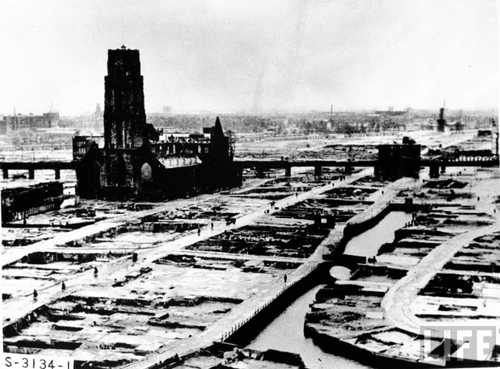
Homefront
Why "Rotterdam is anywhere" (as the song goes) ...
Aftermath of the bombing of central Rotterdam, 14 May 1940, by the bombers of Luftwaffe KG.54. Neither side seem to have wanted this devastation; it seems to have come about due to a series of mischances and miscalculations. The German forces arriving in the south of the city on 13 May (principally elements of the 9th Panzer Division and the LSSAH SS Motorised) appear to have requested air support in the form of Stukas to support an attack into the city to relieve German forces holding an area around the bridges over the Nieuwe Maas, and to secure the bridges. A proposed withdrawal of these troops (other than those strictly required to hold the bridges themselves) had proved largely unsuccessful, due to poor communications and action by Dutch forces. Higher Army and Luftwaffe command, however, appear to have taken the view that a major air attack, which would force Dutch capitulation, - or at least the threat of such an attack - was necessary. As a result, in addition to the Stukas, an attack including some 90 He-111 medium bombers, was planned. It was under threat of this that the Dutch found themselves negotianting the possible surrender of the city. There was a certain lack of urgency on the part of the Dutch in the early stages of negotiation; they still hoped to recapture and destroy the bridges before the Germans could secure and use them. Progress was made in the negotiations by the time the German ultimatum, backed up by the threat of air attack, was imminent. In consequence, the air attack order was rescinded. However, by the time the recall order was issued, the He-111s were in the air, and had pulled in the external cable radio aerials that allowed them to stay in contact with their headquarters, leaving them with local command radio communications only - normal operating procedure at the time. When they arrived at the target, mist and smoke from Dutch anti-aircraft fire preveted the majority of the aircraft from identifying the red flares that were supposed to be the backup signal of recall. One Luftwaffe commander did see the flares, and managed to divert about 30 of the Heinkels to secondary targets; the remaining 60-odd went ahead and bombed the area to the north of the Nieuwe Maas bridges. This would have caused considerable damage to the area, but that damage might have been expected to be limited by the fact that high-explosive, rather than incendiary bombs were being carried. However, flammable goods in the warehouses in the Nieuwe Maas area were ignited including, apparently, a large warehouse storing margarine and vegetable cooking oils. This started a huge fire, that required several days and firefighting units summoned from a large part of western Germany to bring under control. By the time the smoke cleared, the historic port of Rotterdam had been largely destroyed - an outcome convenient to nobody - and the Dutch had long capitulated. I was in Rotterdam recently. I know it is a vibrant city and, for many, a good place to live - but when I look at the bland and/or dreary New that grew to replace the Old after the war, it seems to me that the bombing (capped by later bombardments as the Allies came to recapture it in 1944) inflicted a blow to the city from which, in an improtant sense, it has never recovered. Nowaday, Rotterdam really could be anywhere - anywhere at all. Sad. JR.
1715 Views
6/11/2010
